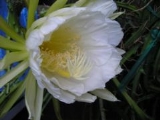Selenicereus hamatus is a
speciesIn biology, a species is one of the basic units of biological classification and a taxonomic rank. A species is often defined as a group of organisms capable of interbreeding and producing fertile offspring. While in many cases this definition is adequate, more precise or differing measures are...
of Cactaceae and produce one of the largest flowers in the family. It is a cultivated ornamental vine. The species is native to
MexicoThe United Mexican States , commonly known as Mexico , is a federal constitutional republic in North America. It is bordered on the north by the United States; on the south and west by the Pacific Ocean; on the southeast by Guatemala, Belize, and the Caribbean Sea; and on the east by the Gulf of...
.
History
Scheidweiler thought that this species originally came from Mexico and this is probably correct. But, still no evidently wild plant has been found. Even though a quite common species, not much is known about its history.
Systematics
S. hamatus is a distinct species, distantly related with the grandiflorus-compex.
Selenicereus radicans (DC.) A. Berger seems to belong here, but it's impossible to know for sure as the original description is brief and no type seems to exist. The publication of
Cereus radicans predates
C. hamatus.
Cultivation
An easily cultivated, fast growing plant. Needs a compost containing plenty of humus and sufficient moisture in summer. Should not be kept under 10ºC (50ºF) in winter. Can be grown in semi-shade or in full sun. Extra light in the early spring will stimulate budding. Only mature plats produces flowers. It will make an excellent pendent plant.
Description
Stems scandent, clambering or sprawling, branching, producing few aerial roots, very vigorous, to 5-12 m long or more, often growing 2 m or more in a season, 16-22 mm thick; ribs 4 or rarely 3-5, strong, later terete, acute; areoles small, brownish or black, remote, on the upper edges of knubby projektions, these often forming obtuse, deflexed spurs about 1 cm long, internodes 4-5 cm; spines 5-6, ca 5 mm long, whitish, bristle like, 1-3 lower or central spines usually brown or black; epidermis glossy grass or light green. Flowers produced one by one over a longer period than most other species, born sparingly near tips of mature stems, 30-40 cm long, 20-30 cm in Ø, nocturnal and strongly scented with an aromatic fragrance, tepals rotate, inner ones forming a broad cup; pericarpel oval, knobby, ca 4 cm thick, covered with white spines and brown or black hairs, bracteoles green with white tips.; receptacle ca 10-14 cm long, green, purplish towards the apex, ca 22 mm in Ø, its areoles with short, retuse, 1-12 mm long bracteoles, long black hairs and spines, upper bracteoles longer, the uppermost tipped purple; outer tepals 15 cm long, in 4 series, the outermost more narrow, reddish purple outside, chrome yellow inside, innermost broader, to 2 cm, acute to acuminate, greenish yellow outside, chrome yellow inside; inner tepals 12 cm, in 3 series, very broad, retuse, mucronate, white; stamens creamy white, anthers yellow; style thick, longer than the stamens, yellowish, lobes 15-18. Fruit oval, 10x8 cm, green or yellow, covered densely with yellowish spines, 2,5 cm long.
The source of this article is
wikipedia, the free encyclopedia. The text of this article is licensed under the
GFDL.


